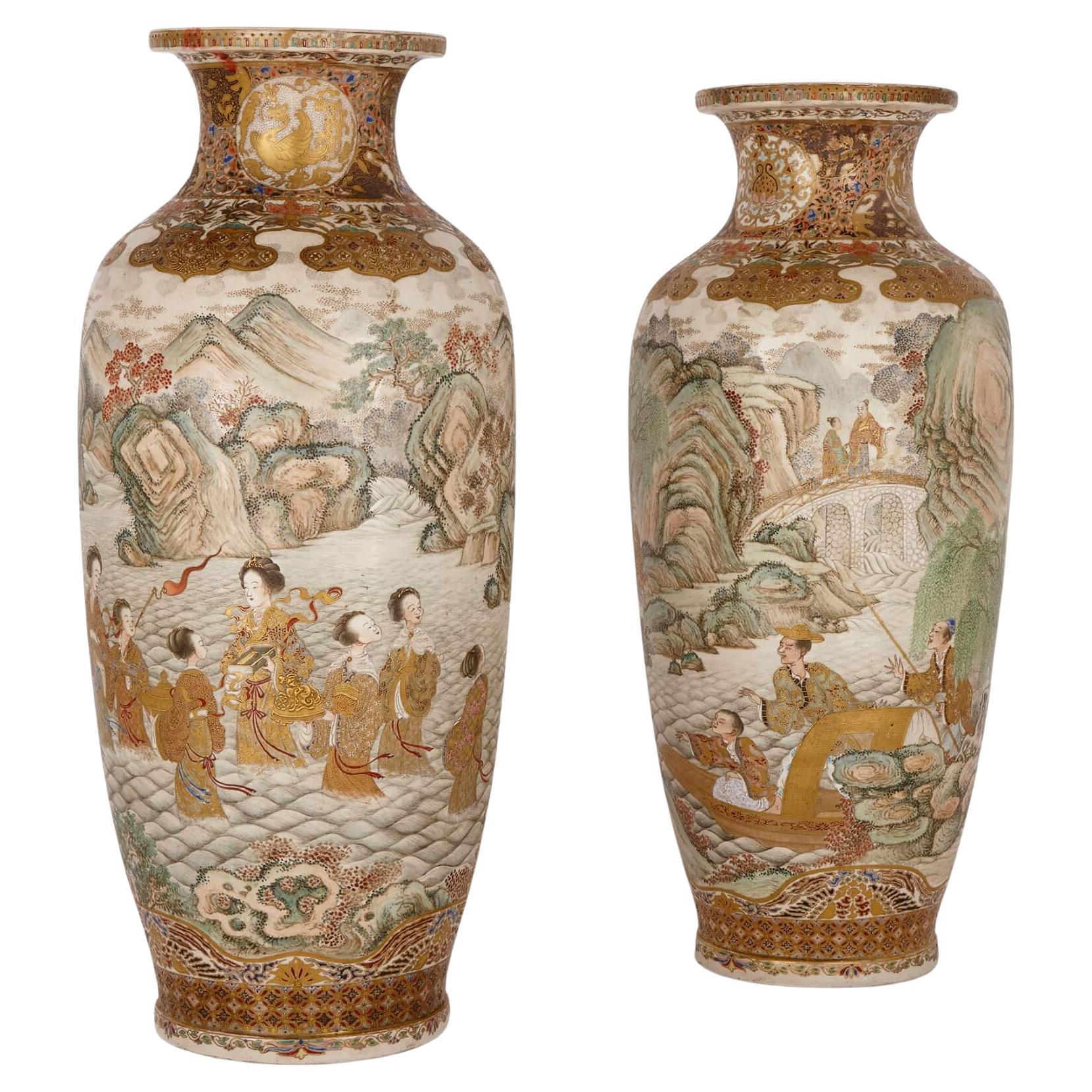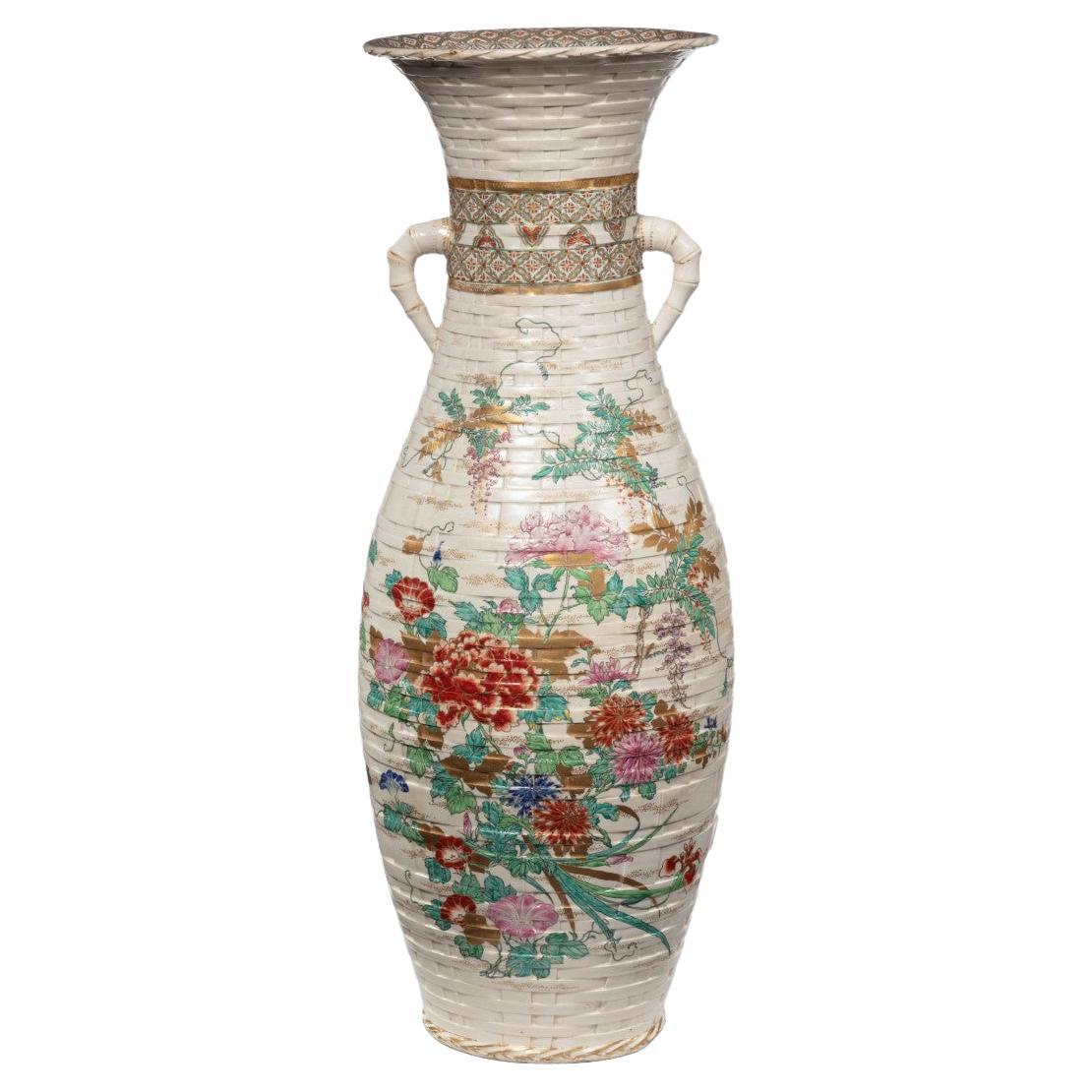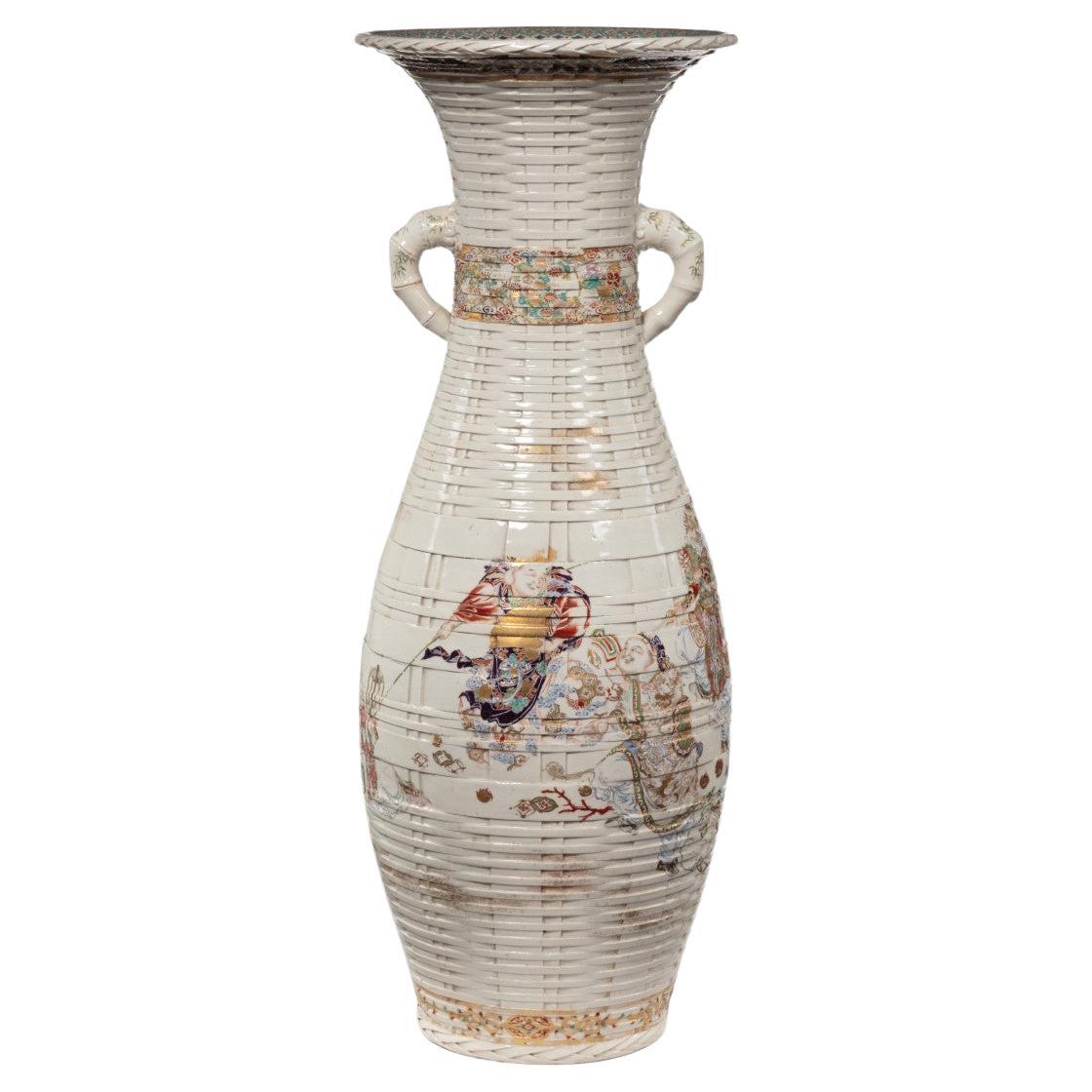Items Similar to Pair of Satsuma Ceramic Vases Mounted on French Bronze, Period: Meiji, 19th
Want more images or videos?
Request additional images or videos from the seller
1 of 8
Pair of Satsuma Ceramic Vases Mounted on French Bronze, Period: Meiji, 19th
About the Item
Elegant pair of ovoid ceramic vases mounted on French bronze, decorated with polychrome enamels in relief and pure gold on a white background.
The body is decorated with large cartouches representing high dignitaries in interiors.
The scenes are framed by numerous geometric motifs mixing a wide range of enamel shapes and colours in blue, green and red-orange tones.
Numerous gold highlights give this type of object the qualification of "gold brocade satsuma".
The mounts are made of chased and gilded bronze in the Asian style with a circular openwork base resting on four small feet in the shape of swans' beaks.
Ceramic from the Satsuma kilns, from the MEIJI period (1868-1912) and bronze mountings from the end of the 19th century (Old oil lamp).
Period : Meiji - 19th century
Dimensions : Height : 31cm x width : 16cm - Diameter of base : 17cm
Japanese ceramics experienced an unprecedented development from the 16th century onwards, when the fascinating tea ceremony was codified.
But at the time, the Japanese archipelago was in ruins, ravaged by years of civil war.
It went to war with its neighbour, Korea, between 1592 and 1598, and returned with prisoners, who turned out to be skilled craftsmen: camphor producers, beekeepers, roofers, surveyors and potters.
These were all areas that Japan had not mastered, and he learned their techniques to become one of the undisputed masters.
Satsuma porcelain has a particular style and a colourful and luxurious ornamentation.
Satsuma is the name of an ancient province of Japan, south of Kyûshû, which was united with the province of Osumi to form the current prefecture of Kagoshima.
The White Satsuma style is characterised by its eggshell colour with a transparent crackled glaze, its very fine clay, giving a compact stoneware but also its very precise but also very heavy decoration, almost systematically using gold in large quantities.
He combines abstract geometric forms and realistic illustrations (flowers, birds) in patterns or realistic scenes, commonly using the human figure in a style close to that of prints.
- Dimensions:Height: 12.21 in (31 cm)Diameter: 6.7 in (17 cm)
- Sold As:Set of 2
- Materials and Techniques:
- Place of Origin:
- Period:
- Date of Manufacture:19th Century
- Condition:
- Seller Location:CRÉTEIL, FR
- Reference Number:1stDibs: LU7814232857702
About the Seller
4.0
Vetted Seller
These experienced sellers undergo a comprehensive evaluation by our team of in-house experts.
1stDibs seller since 2022
9 sales on 1stDibs
Typical response time: Several days
- ShippingRetrieving quote...Ships From: CRÉTEIL, France
- Return PolicyA return for this item may be initiated within 14 days of delivery.
More From This SellerView All
- Pair Of Lalique Vases - Dampierre - Satin Molded Crystal - Period: 20th CenturyBy René LaliqueLocated in CRÉTEIL, FRDelightful pair of vases by Lalique, the "Dampierre" model Made from clear crystal, moulded with a satin finish and decorated with birds in relief. Designed by Marc Lalique in 1948...Category
20th Century French Art Deco Vases
MaterialsCrystal
- Pair Of Lalique Vase - Molded Crystal - Elisabeth - Period: XXth Style Art DecoLocated in CRÉTEIL, FRLovely pair of vases from the house of Lalique "Le Vase Elisabeth The Elisabeth vase is made of moulded, pressed, partially satin-finished crystal and was created by Marc Lalique ...Category
20th Century French Art Deco Vases
MaterialsCrystal
- Old Lard Stone, Vine and Grapes, Period, Late 19th Century, Quing DynastyLocated in CRÉTEIL, FRVery beautiful Far Eastern work in "lard stone". The finely carved base is in brown stone. This sculpture represents a vine with generous and abundant foliage and bunches of grape...Category
Antique 19th Century Asian Napoleon III Vases
MaterialsStone, Marble
- Pyrogen, Bronze Character on Cherry Marble Base, Period, 19th CenturyLocated in CRÉTEIL, FRPyrogen representing a figure in bronze. His face is jovial and he holds a tankard in his left hand. He is screwed on a griotte marble base. The scraper is between the shoes. Period: 19th century Dimensions : Height : 12cm - Diameter of the base : 8cm Pyrogenes are match holders, very common before the generalization of lighters, very useful because they can be portable. In the absence of electricity, they were necessary as well to light a stove as a paraffin lamp...Category
Antique 19th Century Figurative Sculptures
MaterialsMarble, Bronze
- Pair of Gilt Bronze Candlesticks Attributed to F.Barbedienne Period 19th CenturyBy Ferdinand BarbedienneLocated in CRÉTEIL, FRLovely pair of gilt bronze candlesticks, attributed to Ferdinand Barbedienne. The tripod base in the shape of lions' paws is surmounted by a collar formed of aquatic vegetation where a salamander wanders. On the fluted, elegant and straight was another salamander hastens to find its congener. The shoulder supporting the four light arms in the shape of an oil lamp is highlighted by three African elephant heads. The sockets are original and removable. A magnificent fantastic creature, guardian of this royal and symbolic fauna, half man, half animal, serving as an extinguisher, comes to magnify the whole of this sublime achievement of quality in all respects. Period: Late 19th century Dimensions: Total height: 55.5cm x width: 16cm The elephant is often seen as a symbol of strength and power. Being a large and magnificent animal, it is quite logically considered a powerful and majestic creature. His way of life, dependent on the herd, is at the origin of deep relational bonds based on loyalty, which develop the power and the will to defend others. The salamander had an amazing reputation for walking through flames. This alleged power has earned him, among other things, to be a royal symbol. With this exceptional power, the salamander was chosen by one of our most flamboyant kings, François 1er...Category
Antique 19th Century Napoleon III Candlesticks
MaterialsBronze
- Campaniform Glass on Foot, Murano, Period: First Tiers 20thLocated in CRÉTEIL, FRLovely glass, campaniform, on foot, iridescent pink color. Its cut has lobed edges, decorated on the lower rim with a very pretty chain with gold powder inlay. A ribbed sphere, fi...Category
20th Century Art Nouveau Vases
MaterialsGlass
You May Also Like
- A pair of large Meiji period Satsuma Rouleau vasesLocated in London, GBA pair of large Meiji period Satsuma Rouleau vases Japanese, Late 19th Century Height 54.5cm, diameter 24cm These beautiful Satsuma-ware vases were made ...Category
Antique Late 19th Century Japanese Meiji Ceramics
MaterialsEarthenware
- Fine Japanese Satsuma Vase Hand-Painted marked base, 19th Century Meiji PeriodLocated in Lincoln, LincolnshireThis is a very good quality Earthenware Japanese Satsuma vase, beautifully hand decorated and from the Meiji period, circa 1875. The vase has a he...Category
Antique 19th Century Japanese Meiji Vases
MaterialsEarthenware
- Large Meiji Period Satsuma Earthenware Floor VaseLocated in Lymington, HampshireA large Meiji period Satsuma earthenware floor vase, the of baluster form, painted in pastel overglaze enamels and gilding with two large sprays of flowers including prunus blossom, ...Category
Antique 1870s Japanese Meiji Ceramics
MaterialsEnamel
- Large Meiji Period Satsuma Earthenware Floor VaseLocated in Lymington, HampshireA large Meiji period Satsuma earthenware floor vase, the skittle shaped body painted in pastel overglaze enamels and gilding with a continuous frieze of the Seven Gods...Category
Antique 1870s Japanese Meiji Ceramics
MaterialsEnamel
- Pair of 19th Century Japanese Imari Vases with French Bronze MountsLocated in New Orleans, LAThis gorgeous pair of 19th century Japanese Imari vases are beautifully hand-painted in the classic Imari colors of blue, terra cotta, gold and white. The pair features a Foo dog han...Category
Antique Mid-19th Century Japanese Ceramics
MaterialsBronze
- Japanese Cloisonné Vases Butterflies & Flowers, 19th Century Meiji Period, PairLocated in Lincoln, LincolnshireThese are a very decorative pair of cloisonné vases, made in Japan and dating to the 19th Meiji Period, circa 1875. The vases have a good baluster shape with a circular form. They...Category
Antique 19th Century Japanese Meiji Ceramics
MaterialsCeramic
Recently Viewed
View AllMore Ways To Browse
End French Period
Antique Master Bedroom
Small Ceramic Pair
Pair Of Old Masters
Lamps Made From Vases
Asian Green Vase
Blue And White Vase Lamp
Japanese Roof
Small Vase Lamp
19th Century French Interior Scene
Camphor Antique Furniture
Vase Lamps Red
French Crackle Glaze
Korean 19th
Pair Blue Green Lamps
19th Century Korean
Ceramic Vessel Lamp
Vase Turned Lamp





